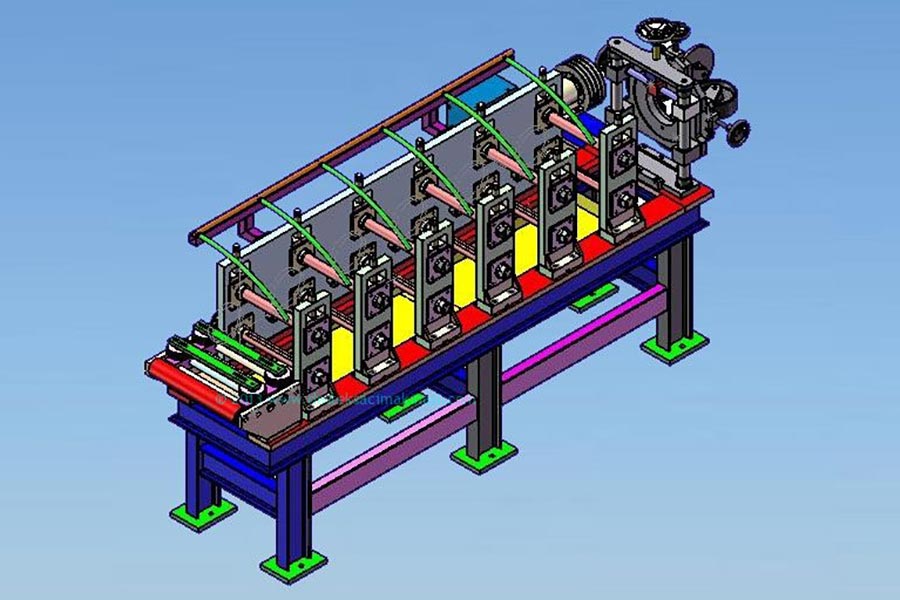
The "Industry 4.0" revolution in the global industry is fundamentally changing production processes and bringing digitalization and automation to the forefront. The Russian Federation is not left out of this global trend and closely follows technological developments and digitalization trends, especially in line with import substitution policies and goals to strengthen the local industry. The roll forming machinery industry is also taking its share of this transformation, and innovations in this field are becoming more and more important in Russia.
Triggers of Technological Developments in Russia
The main factors driving technological developments and digitalization trends in the field of roll forming machines in Russia are:
- Import Substitution and Localization: Russia's efforts to reduce its dependence on Western technologies necessitate the development of the local machinery manufacturing industry. This puts pressure on Russian engineers and companies to develop their own roll-forming machine technologies and modernize existing ones.
- Focus on Efficiency and Cost-Effectiveness: In a competitive market environment, Russian manufacturers also need more efficient and optimized roll forming solutions to reduce costs, increase production speed and reduce scrap rate. Digitalization plays a key role in achieving these goals.
- Quality and Precision Expectations: High quality and precision standards are sought in roll form profiles used in critical sectors such as automotive, infrastructure and energy. This requires more advanced control systems and measuring equipment in machine technology.
- Following Global Trends: Concepts such as Industry 4.0, Internet of Things (IoT), Artificial Intelligence (AI) and Big Data analysis are closely followed by Russian industrialists and tried to be integrated into production processes.
Digitalization Trends in Roll Forming Machines
The main trends of digitalization and technological development observed in Russia and in the roll form industry in general are:
- Advanced Control Systems and Automation:
- CNC (Computer Numerical Control) Integration: CNC control systems have become standard in modern roll forming machines. These systems allow production parameters to be precisely adjusted, profile changes to be made quickly, and human error to be minimized. Russian manufacturers focus on the local integration of these systems and software development.
- Robotic Applications: As part of automation, the use of robotic arms is becoming widespread, especially in processes such as profile loading/unloading, packaging and palletizing. This increases occupational safety and maximizes production speed.
- Internet of Things (IoT) and Sensor Technologies:
- Real-Time Data Collection: Critical data such as speed, temperature, pressure, motor current are continuously collected through the sensors integrated into the machine. This data is used to monitor the current status of the production process and detect potential problems in advance.
- Predictive Maintenance: Thanks to IoT data and analytical algorithms, machine failures can be predicted in advance. This reduces unplanned downtime, lowers maintenance costs and extends machine life. Software and hardware development work in this field has gained momentum in Russia.
- Artificial Intelligence (AI) and Machine Learning (ML) Applications:
- Process Optimization: AI algorithms can determine the most efficient parameters of the roll forming process by analyzing the big data collected. It makes automatic adjustments according to the material type, thickness and desired profile form, ensuring optimum production quality and speed.
- Error Detection and Quality Control: Image processing and AI-powered systems can detect surface defects, dimensional deviations, and other defects in manufactured profiles in real-time. This ensures product quality while reducing the scrap rate.
- Digital Twin Technology:
- Virtualization and Simulation: By creating a digital twin of the roll forming machine and the production process, tests and optimizations can be made in a virtual environment before making a physical production. This speeds up the prototyping process of new products and reduces production risks. Russian engineers invest in software and simulation tools in this area.
- Remote Monitoring and Diagnosis:
- Cloud-Based Solutions: Machine data is stored on cloud-based platforms and can be accessed remotely, allowing manufacturers to monitor production processes and diagnose problems from anywhere in the world. This facilitates technical support and service, especially in large geographies such as Russia.
The specific dynamics of developments in Russia
There are some special dynamics in Russia's technological development journey:
- Local Software and Hardware Development: Restricting access to Western suppliers due to sanctions pushes Russian companies to develop their own local software and hardware solutions. This can increase technological independence in the long run.
- Government Supports and Programs: The Russian government offers various incentives and support programs for the digitalization and modernization of the industry. These programs accelerate companies' R&D and innovation investments.
- Need for Trained Workforce: Skilled engineers and technicians are needed for the effective use of high-tech roll forming machines. Russia is focused on updating educational programs and curricula at technical universities in this area.
Result
The roll forming machinery industry in Russia is undergoing a significant transformation in parallel with global digitalization and automation trends. Import substitution policies and goals to strengthen the local industry further accelerate this transformation. Innovations such as advanced control systems, IoT integration, artificial intelligence applications, and digital twin technology will make roll form production in Russia more efficient, precise, and competitive. This process will consolidate Russia's industrial independence, while at the same time contributing to its unique place in the global machinery manufacturing market.
